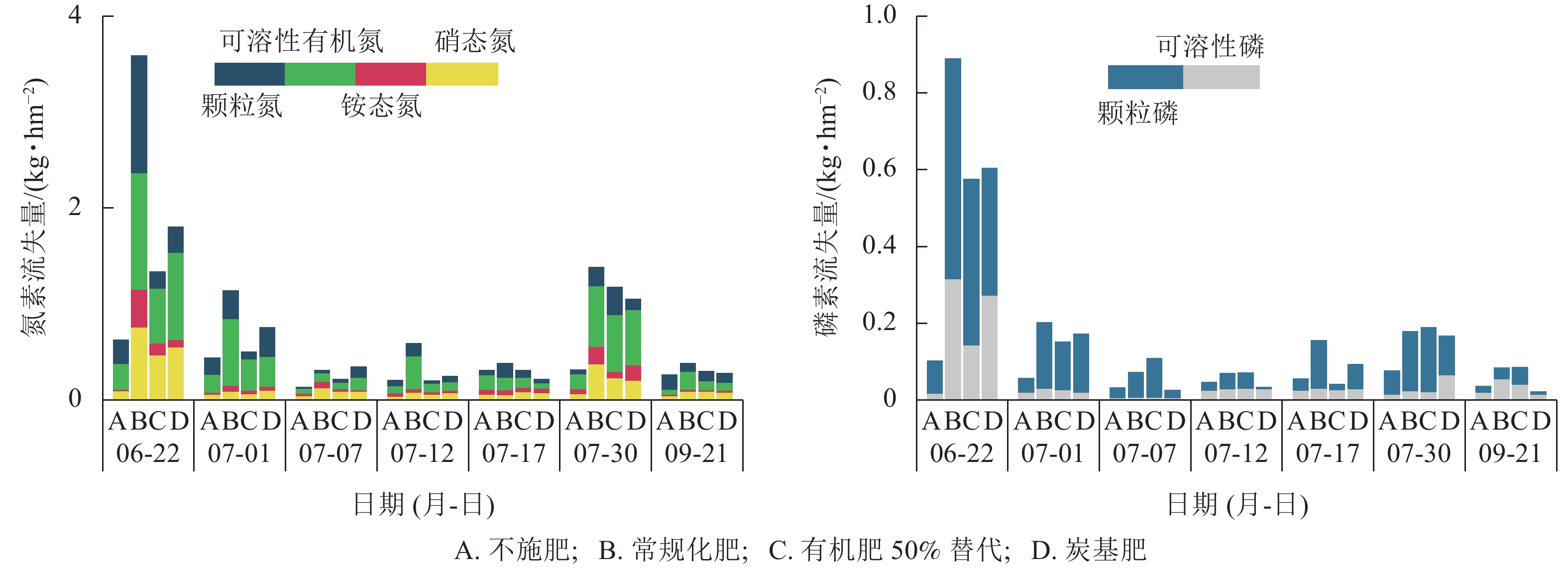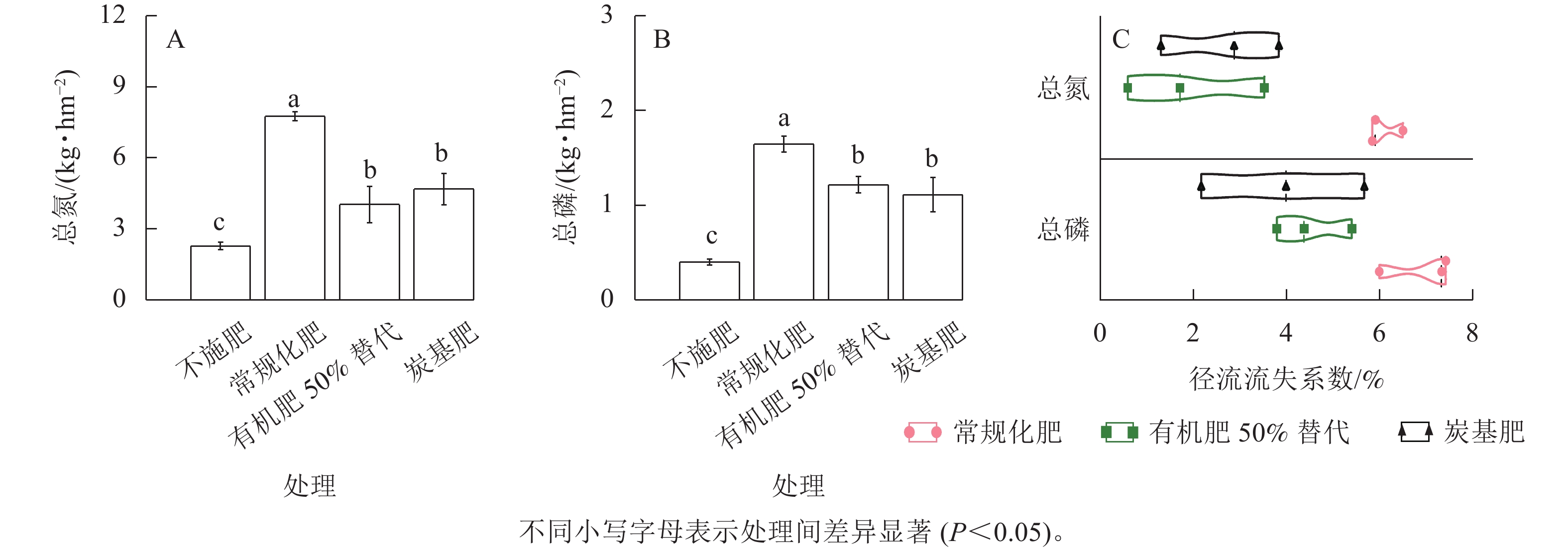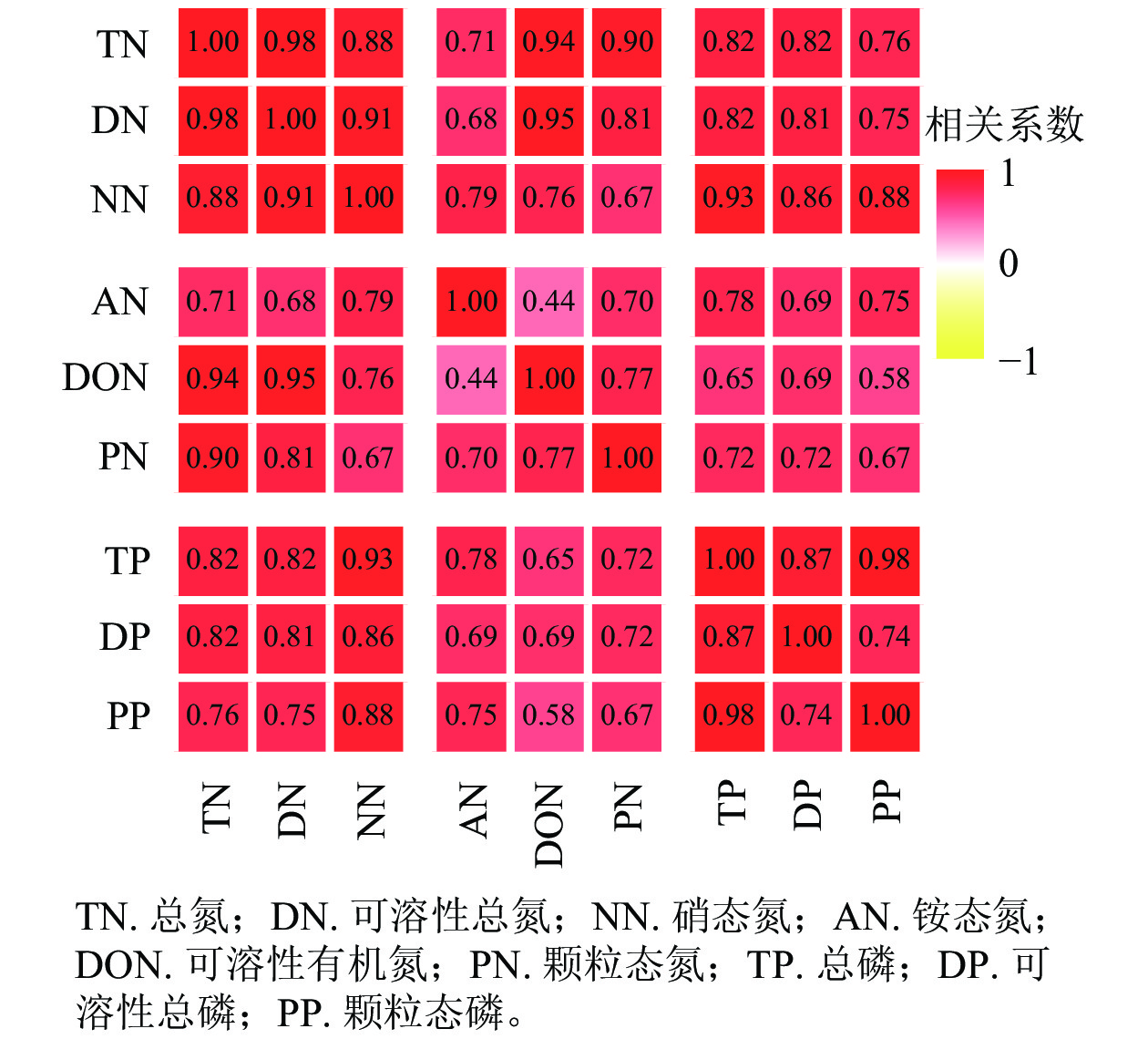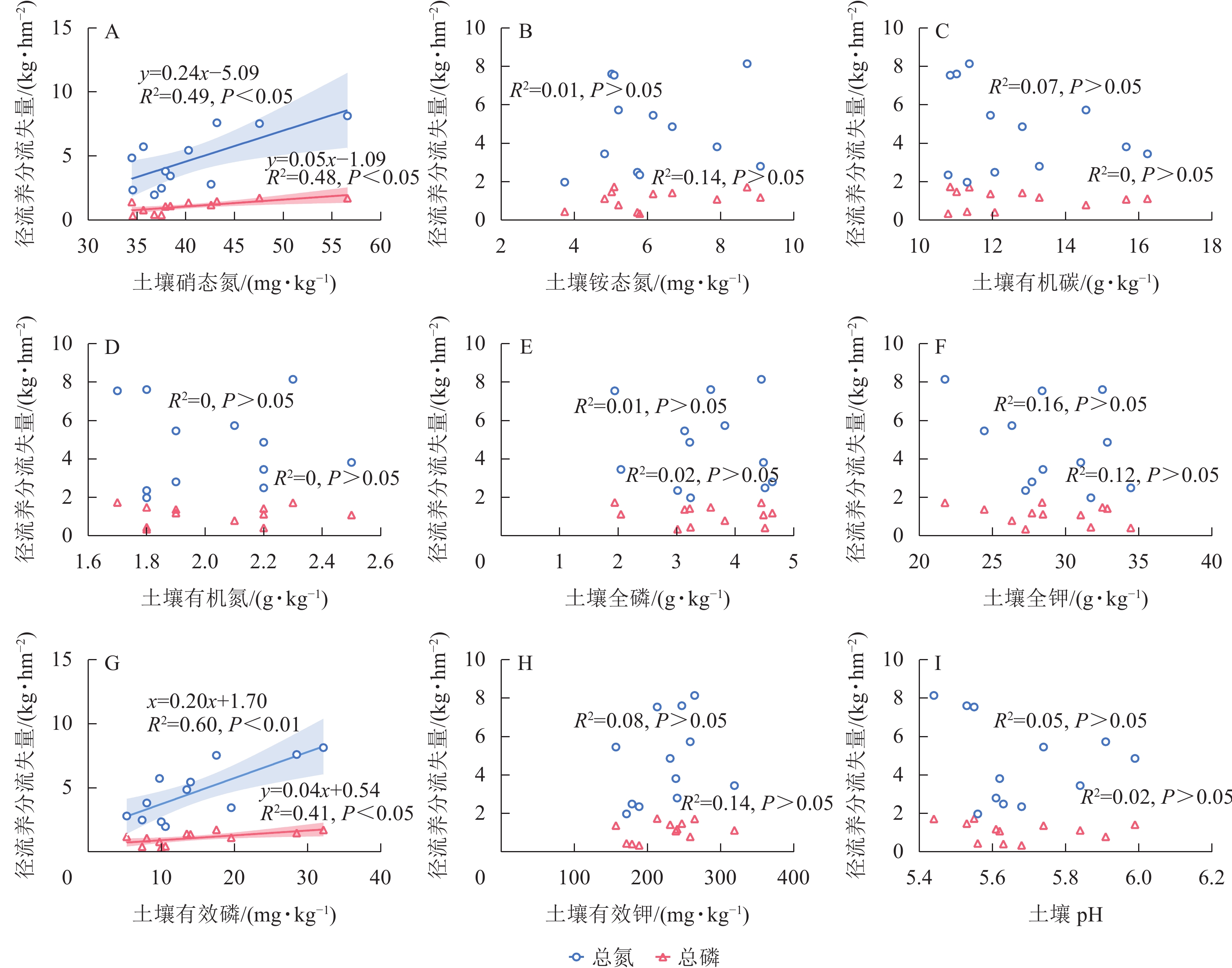-
过量施用无机肥导致地表水体富营养化和土壤退化,从而使土壤生产力下降[1−4]。因此,优化养分管理措施,减少土壤氮磷的流失和提高肥料利用效率迫在眉睫。有机肥和炭基肥替代化肥是减少环境污染和维持作物产量的有效选择[5-7],两者均是通过调整土壤养分供应与作物养分需求,以达到增加肥料利用效率和减少氮磷流失的目的。有机肥养分供应速率取决于有机物质的矿化[8],炭基肥则取决于生物质炭和包覆材料的溶解与扩散[6]。有机肥替代化肥能减少稻田氮素淋溶和径流损失8.7%~25.6%[9-10] 并提高水稻Oryza sativa产量21%~24%[11],水稻氮素利用效率随有机肥比例的增高而增高,但有机肥比例超过 75%则氮素利用效率降低[10]。炭基肥能减少烟草Nicotiana tabacum地氮素淋溶损失的6.45%~8.36%,但减少氮素淋溶效应量随炭基肥添加量的增加而降低[12]。有机肥及炭基肥替代化肥对氮素利用效率和产量的影响效应量大小受肥料类型、施用量、替代率、栽培类型和作物种类影响。如相比尿素,炭基肥能分别提高茶Camellia sinensis 、肉桂Cinnamomum cassia和甜瓜Cucumis mel 产量43%、166%和 176%[13]。坡耕地土壤有着更高侵蚀风险,且即使同为坡耕地,种植甘薯Ipomoea batatas比荒草和谷子的侵蚀风险更高[14]。由于氮磷流失方式的间歇性、流失时间的随机性、流失机制的复杂性、流失途径和流失量的不确定性[15],坡地强化径流的条件下,甘薯坡耕地采用有机肥和炭基肥替代化肥的措施对氮磷养分径流损失的影响难以预测。本研究旨在探讨有机肥和炭基肥替代化肥对甘薯坡耕地土壤径流氮磷流失质量浓度、径流氮磷流失量及其形态的影响,同时分析了径流养分流失量和土壤化学性质之间的关系,以期为甘薯坡耕地径流流失情况和施肥管理措施提供理论依据。
-
研究区位于浙江省杭州市临安区板桥镇葱坑村( 30°05′27.64″N,119°44′03.44″E)。该区属亚热带湿润季风气候,四季分明,年日照时数为1 946 h,无霜期为239 d,年平均气温为15.8 ℃,年平均降水量为1 629 mm。海拔为150 m,土壤为红壤土类黄红壤亚类。
-
按照随机区组设计4个施肥处理(表1):不施肥(对照)、常规化肥、50%质量分数有机肥+50%质量分数化肥(有机肥50%替代)、炭基肥,每个处理重复3次,小区面积为30 m2。为防止发生侧渗和串灌,各小区之间均用水泥浇灌了宽20 cm,深30 cm的水泥墙。每个小区均配有1个单独的排水口和坡地径流池用于采集地表径流水。甘薯 ‘清香’I. batatas ‘Qingxiang’等高起垄栽插薯苗,行距50 cm,株距30 cm,密度为6.8 万株·hm−2。2020年6月8日施基肥,6月9日移栽插秧,7月20日施追肥,肥料均匀撒施后翻耕,肥料施于土层0~5 cm处。于2020年10月24日收获。
处理 施用量/(kg·hm−2) m(氮)︰m(五氧化二磷)︰
m(氧化钾)基肥 追肥 不施肥(对照) 0 0 0︰0︰0 常规化肥 尿素 195.66;钙镁磷肥 500.00;
硫酸钾 577.00尿素 195.66;钙镁磷肥500.00;
硫酸钾 577.0090︰60︰300 50%质量分数有机肥+50%质量
分数化肥 (有机肥50%替代)菜籽饼900.00;尿素 97.67;
钙镁磷肥312.67;硫酸钾 559.67菜籽饼900.00;尿素 97.67;钙
镁磷肥312.67;硫酸钾 559.6790︰60︰300 炭基肥 炭基肥500.00;钙镁磷肥291.67;硫
酸钾480.67炭基肥500.00;钙镁磷肥291.67;
硫酸钾480.6790︰60︰300 说明:尿素中氮质量分数为46%;钙镁磷肥中五氧化二磷质量分数为12%;硫酸钾中氧化钾质量分数为52%;菜籽饼中m(氮)∶m(五氧化二磷)∶m(氧化钾)∶m(碳)=5.0∶2.5∶1.0∶46.0,有机质质量分数为85%;炭基肥由遂昌绿金有机肥有限公司研制,m(氮)∶m(五氧化二磷)∶m(氧化钾)∶m(碳)=18∶5∶10∶25,直径为2~4 mm。其中,生物质炭质量分数为12%,由稻草通过在400~500 ℃缓慢热解,在无氧条件下热解1 h。生物炭质比表面积和孔体积分别为224.2 m2·g−1和0.11 cm3·g−1。 Table 1. Fertilizer types and rates
-
分别在2020年的6月22日、7月1日、7月7日、7月12日、7月17日、7月30日及9月21日收集地表径流,先测量径流池水位高度以计算径流水量,再将池内径流水充分搅匀,最后在池中不同部位、不同深度用采水器进行多点混合采集。水样置于4 ℃保存,并带回实验室即刻处理。
收获甘薯后,每个小区随机选择 5 个位置采集 0~20 cm 土层土样,充分混合后组成一个土样。在土壤样品采集过程中,使用不锈钢容重环刀(直径5.05 cm,高5.00 cm)采集土壤容重样品。将样品分为2份,1份湿土除去可见的根,过 2 mm 筛,用于测定土壤铵态氮和硝态氮。另1份风干,除去可见的根和有机物,然后木盘研磨并过2 mm筛,用于测定土壤pH、速效钾、有效磷。再从过2 mm 筛土壤样品中挑选部分土样用玛瑙研钵研磨并过0.15 mm 筛,用于测定土壤有机碳、总氮、总磷和总钾。
-
径流水样总氮、可溶性氮采用碱性过硫酸钾消解紫外分光光度法(GB 11894—1989)测定。径流水样总磷和可溶性磷采用过硫酸钾消解钼蓝比色法(GB 11893—1989)。径流水样铵态氮和硝态氮采用间断分析仪测定。采用 pH 计法测定径流水样 pH。
土壤样品中的有机碳和总氮采用元素分析仪测定;土壤全磷采用高氯酸-硫酸消煮、钼锑抗比色法测定;土壤全钾采用氢氧化钠熔融、火焰光度法测定;土壤有效磷采用0.030 mol·L−1氟化铵-0.025 mol·L−1盐酸浸提、钼锑抗比色法测定;土壤速效钾采用醋酸铵浸提、火焰光度法测定;土壤硝态氮、氨态氮采用氯化钾浸提—间断分析仪测定。
-
氮磷流失量(R, kg·hm−2):
$ R = \displaystyle \sum\limits_{n = 1}^n {{C_i}} {V_i} $ ;氮磷流失系数(Cr):$ {C}_{\text{r}}=({R}_{\text{m}}-{R}_{0})/{R}_{\text{f}} $ ;颗粒态氮(PN)质量浓度(NP,mg·L−1):$ {N_{\rm{P}}} = {N_{\rm{T}}} - {N_{\rm{D}}} $ ;颗粒态磷(PP)质量浓度(PP,mg·L−1):$ {P_{\rm{P}}} = {P_{\rm{T}}} - {P_{\rm{D}}} $ ;可溶性有机氮(DON)质量浓度(NDO,mg·L−1):$ {N_{{\rm{DO}}}} = {N_{\rm{D}}} - {N_{\rm{N}}} - {N_{\rm{A}}} $ 。其中:Ci为第 i 次径流水中氮、磷的质量浓度(mg·L−1);Vi为第 i 次径流水的体积(m3);n为总径流次数;Rm为不同施肥类型氮磷流失量;R0为不施肥氮磷流失量;Rf 为不同施肥类型肥料施用量;NT为总氮(TN)质量浓度(mg·L−1);ND为可溶性总氮(DN)质量浓度(mg·L−1);PT为总磷(TP)质量浓度(mg·L−1);PD为可溶性总磷(DP)质量浓度(mg·L−1);NN为硝态氮(NN)质量浓度(mg·L−1);NA为铵态氮(AN)质量浓度(mg·L−1)。利用SPSS 26.0进行数据统计分析,采用单因素方差分析和邓肯法多重比较检验不同处理间的差异显著性(P<0.05)。利用主成分分析(PCA)确定径流氮磷及其形态之间相互依存的结构。利用冗余分析(RDA)检查土壤特性与土壤径流氮磷及其形态之间的关系。
-
重复测量模型(图1)表明:不同处理、径流产流时间及其相互作用对径流总氮、颗粒氮、硝态氮和铵态氮质量浓度均存在显著影响(P<0.05),地表径流总氮、颗粒氮、硝态氮和铵态氮质量浓度存在峰值效应,并且不同径流产流过程中不同处理的影响也不同。施肥初期,与常规化肥相比,有机肥50%替代和炭基肥处理的径流总氮质量浓度分别减少了58.4%和49.0%;颗粒氮质量浓度分别减少了84.5%和78.3%;硝态氮质量浓度分别减少了32.1%和26.4%;铵态氮质量浓度分别减少了66.1%和80.0%。施肥中后期,常规化肥、有机肥50%替代和炭基肥对径流中总氮、颗粒氮、硝态氮和铵态氮质量浓度的影响较小。
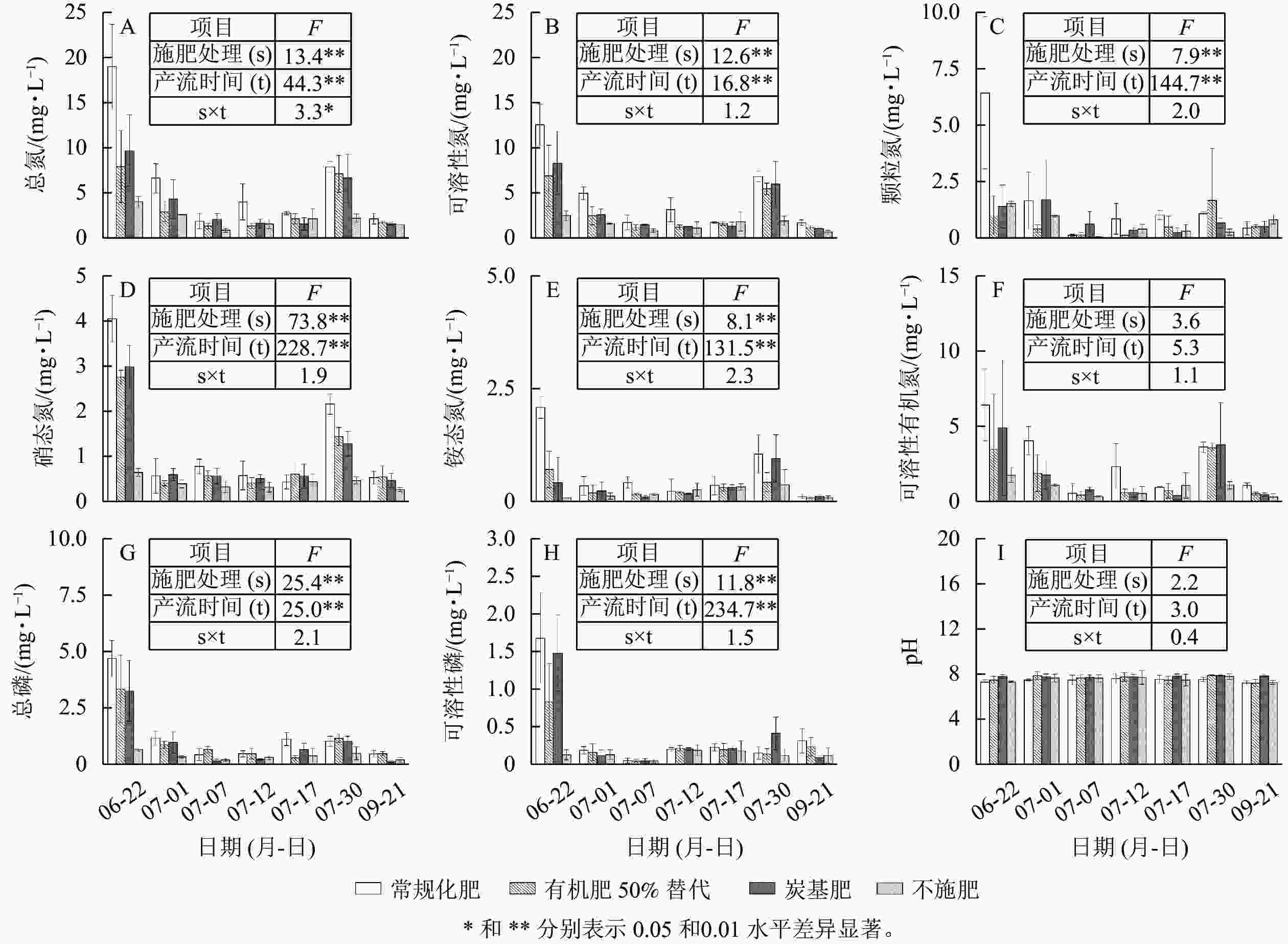
Figure 1. Effects of fertilizer types and runoff dates on nitrogen, phosphorus contents and pH value in the runoff
不同处理和径流产流时间显著影响径流可溶性氮和总磷质量浓度(P<0.05),且不同肥料类型的影响趋向一致。无论径流产流时间如何变化,有机肥50%替代处理的径流中可溶性氮和总磷质量浓度分别为5.23 、1.03 mg·L−1,炭基肥处理的径流中分别为2.85、0.91 mg·L−1,均显著低于常规化肥处理(分别为8.59 和1.33 mg·L−1)。
径流产流时间显著影响径流可溶性有机氮和可溶性磷质量浓度(P<0.05),但两者并不受不同处理的影响(P>0.05)。另外,pH并不随径流产流时间变化而变化(P>0.05),常规化肥处理中pH值(7.45)低于有机肥50%替代(7.62)和炭基肥(7.79)处理。
-
由图2A可见:在7次径流产流中,不同处理的径流流失量均无显著差异(P>0.05)。对于常规化肥处理,第1次降雨的径流氮素流失量占全年径流流失总量的46.2%,在这个时期,有机肥50%替代和炭基肥处理可分别减少总氮流失量1.78和1.25 kg·hm−2、硝态氮流失量0.29和0.21 kg·hm−2、铵态氮流失量0.27和0.32 kg·hm−2、可溶性有机氮0.64和0.30 kg·hm−2。由图2B可见:第1次降雨时径流中的磷素流失量占全年径流流失总量的53.9%。有机肥50%替代和炭基肥处理可分别减少总磷流失量的35.3%和32.1%、可溶性磷流失量的54.3%和13.5%、颗粒磷流失量的24.9%和42.3%。
-
由图3A和图3B可见:不施肥处理每年径流中的总氮和总磷流失量分别为2.27和0.40 kg·hm−2。常规化肥处理每年径流总氮流失量是7.75 kg·hm−2,分别是有机肥50%替代处理(4.02 kg·hm−2)和炭基肥处理(4.68 kg·hm−2)的1.93和1.66倍。有机肥50%替代和炭基肥处理每年径流总磷流失量分别为1.22、1.11 kg·hm−2,是常规化肥处理(1.65 kg·hm−2)的73.9%和67.4%。
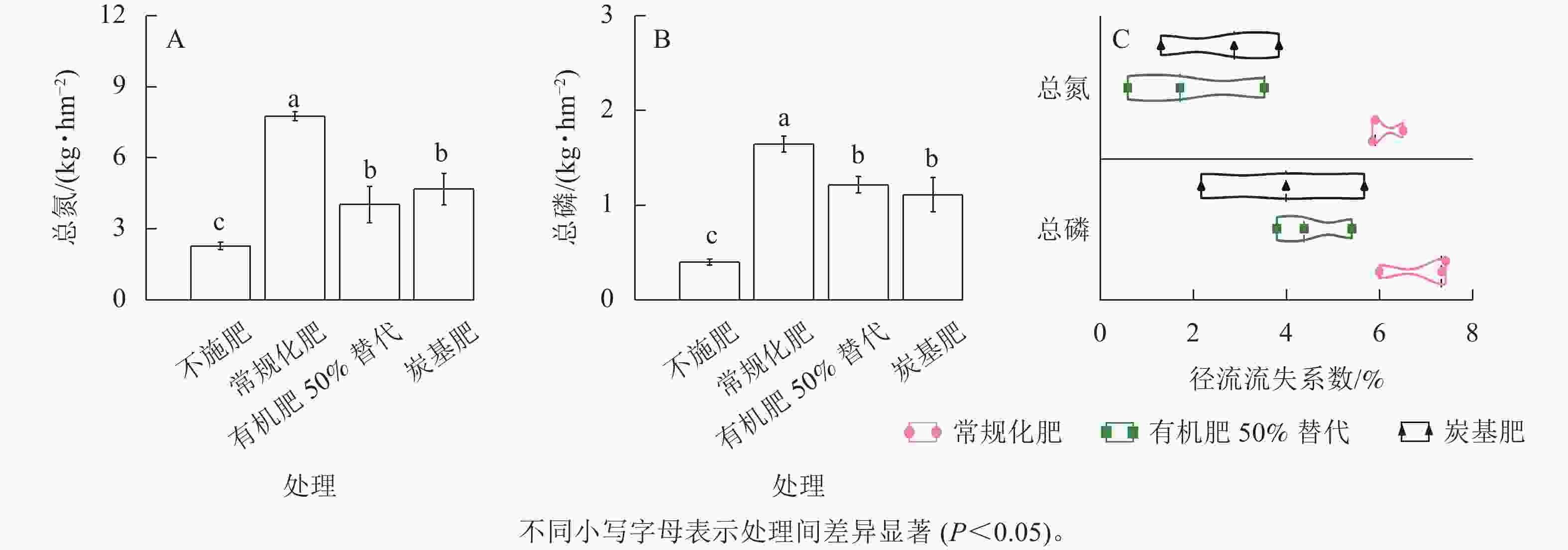
Figure 3. Effects of fertilizer types on total nitrogen (A) and total phosphorus (B) loss rate and runoff coefficients (C) in the runoff
由图3C可见:常规化肥、有机肥50%替代和炭基肥处理总氮流失系数分别为6.09%、1.94%和2.67%, 而总磷流失系数分别为6.91%、4.53%和3.94%。相比常规化肥,有机肥50%替代和炭基肥处理的总氮流失系数分别降低了68.09%和56.11%,而总磷流失系数分别降低了34.54%和43.00%。
-
从表2可见:与常规化肥处理相比,有机肥50%替代和炭基肥处理的土壤有机碳、全磷、全钾、有机氮、铵态氮和有效钾质量分数都有所提高,但除了炭基肥处理显著提高了土壤有机碳质量分数(P<0.05)外,其余处理均未达显著水平。且与常规化肥处理相比,有机肥50%替代和炭基肥处理的硝态氮和有效磷质量分数分别显著降低了18.1%~26.2%和45.0%~65.0% (P<0.05)。
处理 pH 有机碳/
(g·kg−1)全磷/
(g·kg−1)全钾/
(g·kg−1)有机氮/
(g·kg−1)硝态氮/
(mg·g−1)铵态氮/
(mg·kg−1)有效磷/
(mg·kg−1)有效钾/
(mg·kg−1)不施肥 5.62 bc 11.39 b 0.36 a 31.15 a 1.93 a 36.30 b 5.08 a 9.30 b 179.60 b 常规化肥 5.51 c 11.08 b 0.33 a 27.56 a 1.93 a 49.10 a 6.28 a 26.00 a 241.60 ab 有机肥50%替代 5.66 b 13.63 ab 0.41 a 27.73 a 2.10 a 40.28 b 7.72 a 9.10 b 212.10 ab 炭基肥 5.91 a 14.54 a 0.30 a 29.22 a 2.17 a 36.20 b 5.57 a 14.30 b 269.40 a 说明:同列不同小写字母表示差异显著(P<0.05)。 Table 2. Effects of fertilizer types on soil properties
-
与常规化肥处理相比,有机肥50%替代处理使硝态氮和可溶性有机氮的占比分别提高了28%和46%,但使铵态氮和颗粒态氮的占比分别减少了9%和18%;炭基肥处理则使硝态氮和可溶性有机氮的占比分别提高了26%和46%,但使铵态氮和颗粒态氮的占比分别减少了8%和20%(图4A)。常规化肥处理的可溶性磷占比(30%)高于有机肥50%替代处理(25%),而低于炭基肥处理(40%) (图4B)。
-
主成分分析(图5A)发现:2 个轴解释了径流氮磷形态组成中总变异的 90.1%,其中主成分1 对氮磷径流流失形态的贡献率为78.97%,这意味着横坐标是主要的变异因素。本研究中,径流氮磷组分分为 3 个主要组分,并且在主成分1的因素上,有机肥50%替代和炭基肥处理与不施肥、常规化肥处理均显著分开,这表明甘薯坡耕地土壤在经过不同施肥处理后,其径流中氮磷的组分与对照、常规处理相比发生了显著的变化,而有机肥50%替代和炭基肥处理之间的径流氮磷组分趋于一致。冗余分析中两坐标轴能够解释75.86%的关系信息, 说明该结果可较好地反映土壤的化学性质和径流氮磷及其形态之间的关系。冗余分析(图5B)显示:土壤有效磷质量分数与径流氮磷形态组成呈正相关(F=7.0,P=0.007),尤其是常规化肥处理土壤中硝态氮、铵态氮、可溶性有机氮、可溶性总氮、总氮、颗粒态磷、可溶性总磷和总磷径流流失量。
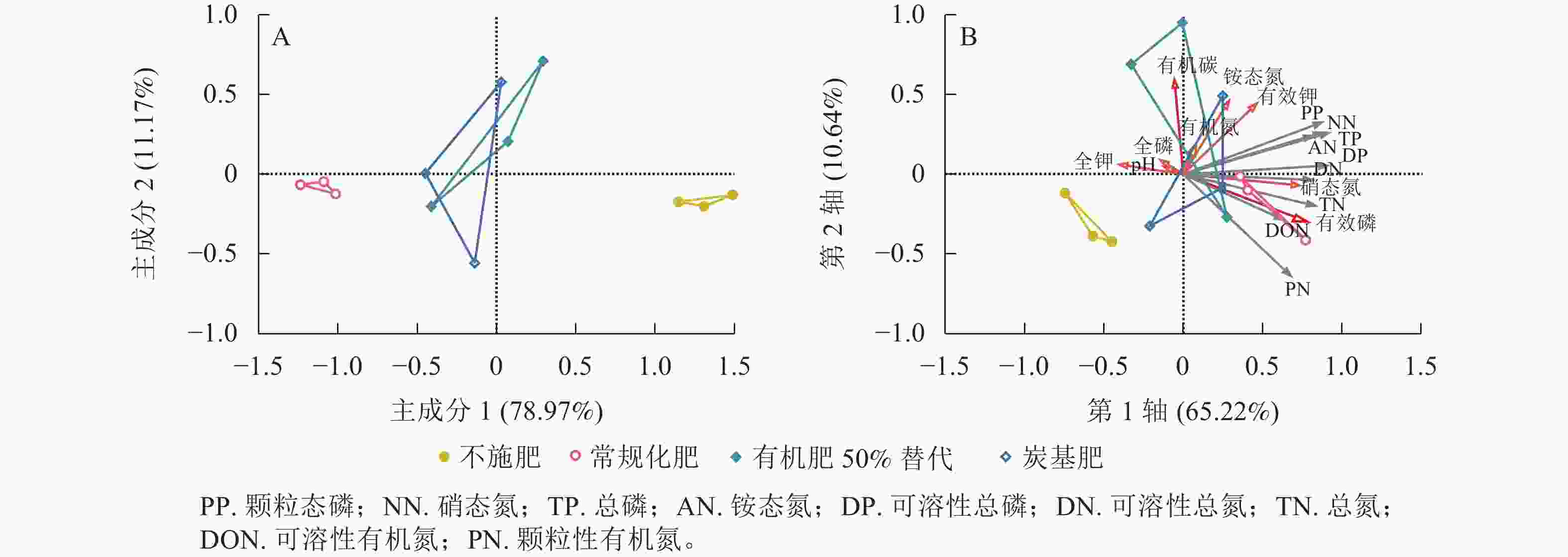
Figure 5. Principal component analysis (A) and redundancy analysis (B) of nitrogen and phosphorus fractions in different fertilizer types
总氮与硝态氮、铵态氮、可溶性有机氮、颗粒态氮和可溶性氮的相关系数分别为0.88、0.71、0.94、0.90和0.98。意味着氮素之间转化是相互依赖和相互转化的。总磷与可溶性磷和颗粒态磷之间的相关系数分别为0.87和0.98,表明各个形态的磷组分间存在显著正相关(P<0.05)。甚至总氮与总磷的相关系数为0.82,即两者之间也呈显著正相关(图6),意味着氮和磷流失量之间为协变关系。径流氮磷流失与土壤化学性质息息相关,如土壤硝态氮能解释径流总氮和总磷的 49%和48%的变化。径流总氮(R2=0.60)和总磷(R2=0.41)流失量随土壤有效磷质量分数增大而增大(图7)。
-
本研究表明:有机肥50%替代和炭基肥处理可减少甘薯坡耕地径流总氮质量浓度。在施肥初期,随着施肥时间延长,它们的效应大小甚至方向趋向一致,这可能与作物生长和施肥有关,在施肥初期植株的保水保肥能力较弱,刚施入的肥料未完全与土壤相结合,易于流失。而氮作为植株生长过程中需求量较大的元素,被植株吸收较多,因此土壤径流中各处理氮的质量浓度大幅降低。而孔文杰 [16]研究发现:有机肥和炭基肥对甘薯坡耕地径流总磷质量浓度的影响不随施肥时间推移而变化。然而,有机肥和炭基肥对稻田和蔬菜径流总磷和总氮的质量浓度影响则相反[17],表明在不同种植模式下有机肥和炭基肥影响径流养分质量浓度的效应是不同的。
不同肥料会影响径流中不同形态氮磷组成,如有机肥50%替代和炭基肥处理均较常规化肥处理可分别提升硝态氮、可溶性有机氮的占比,同时降低铵态氮、颗粒态氮的占比。这是由于有机肥的氮素矿化释放速率慢,以硝态氮和铵态氮形态存在于土壤和径流中相对少,不易发生损失[18]。王静等[19]研究发现:炭基肥对径流中氮磷产生影响的原因可能是增强了土壤持水能力,进而提高可溶性磷和硝态氮含量。肥料类型是影响甘薯氮磷径流流失量的一个重要因素。本研究有机肥50%替代处理较常规化肥处理减少了径流总氮和总磷的流失量,降低了总氮和总磷流失系数,与已有研究结果相同[20-22]。这表明有机肥无论是对菜田、稻田还是坡耕地都能起到减少径流总氮流失量,并能减少坡耕地和菜田径流总磷流失量。然而,有机肥对减少菜地、稻田和坡耕地径流氮磷流失量存在差异[23]。炭基肥处理较常规化肥处理可减少径流氮、磷总量,降低总氮和总磷流失系数,与已有研究结果[24-25]相同。
脱云飞等[26]、陈晓鹏等[27]研究证明:土壤有效磷、硝态氮的质量分数是影响径流氮磷流失量主要因素。本研究表明:径流总磷的流失量与土壤有效磷质量分数呈正相关,磷的移动性很小,径流中有效磷的累积流失量主要取决于径流对地表的冲刷和浸提,有效磷质量分数高的土壤能够有效指示径流携带的含磷量[28],同时王莺等[29]、刘晓玲等[30]在山核桃Carya cathayensis林和稻田上研究发现:土壤有效磷的质量分数与径流总磷流失量的关系与甘薯田基本一致。而地表径流氮素主要来源于土壤表层氮素的冲刷、溶出和淋溶,土壤硝态氮质量分数与径流总氮的流失量呈正比,王琼等[31]对土壤中硝态氮会直接影响径流中氮的流失进行过研究,而徐爱国等[32]在稻田和菜田中证明土壤硝态氮质量分数与径流液总氮流失量并没有显著相关性,表明土壤硝态氮质量分数预测总氮径流流失量因土地利用方式而异[33]。
-
本研究结果表明:①有机肥50%替代和炭基肥处理显著影响径流氮磷流失;相比较常规化肥处理,分别降低径流总氮质量浓度的58.4%和49.0%,降低径流总磷质量浓度的22.6%和31.6%;降低总氮流失量的48.1%和39.6%,降低总磷流失量的26.1%和32.7%。②有机肥50%替代和炭基肥处理改变了径流氮磷形态的组成,相比常规化肥处理显著降低了径流氮磷养分流失系数;有机肥50%替代和炭基肥处理的总氮流失系数分别降低了68.09%和56.11%,总磷流失系数分别降低了34.54%和43.00%。③有机肥和炭基肥施用主要是减少施肥前期氮磷养分的流失。随着施肥时间的延长,有机肥和炭基肥在减少氮磷径流流失与常规化肥施肥并无区别,意味着肥效逐渐递减效应和作物吸收的平衡。④土壤化学性质是影响径流氮磷流失量的主要因素。其中土壤硝态氮的质量分数仅可预测甘薯坡耕地土壤养分的流失,土壤有效磷的质量分数可以指示土壤的养分流失。因此,施用有机肥和炭基肥显著影响了径流氮磷流失,但不同肥料之间影响效果存在差别,比较而言,有机肥50%替代化肥处理更适合用于减少甘薯坡耕地径流氮流失,而炭基肥更适用于减少径流磷流失。合理的施肥措施可以有效减少土壤径流氮磷的流失。
Effects of substituting organic fertilizer and biochar-based fertilizer instead of chemical fertilizer on nitrogen and phosphorus runoff loss in sweet potato sloping farmland
doi: 10.11833/j.issn.2095-0756.20220360
- Received Date: 2022-05-22
- Accepted Date: 2022-11-21
- Rev Recd Date: 2022-10-26
- Publish Date: 2023-05-20
-
Key words:
- organic fertilizer /
- biochar-based fertilizer /
- slope farmland /
- nitrogen and phosphorus runoff loss
Abstract:
| Citation: | CHEN Jiayin, HUANG Chengpeng, ZHENG Mengqi, LI Zihong, WANG Jiayu, JIANG Peikun. Effects of substituting organic fertilizer and biochar-based fertilizer instead of chemical fertilizer on nitrogen and phosphorus runoff loss in sweet potato sloping farmland[J]. Journal of Zhejiang A&F University, 2023, 40(3): 540-549. doi: 10.11833/j.issn.2095-0756.20220360 |












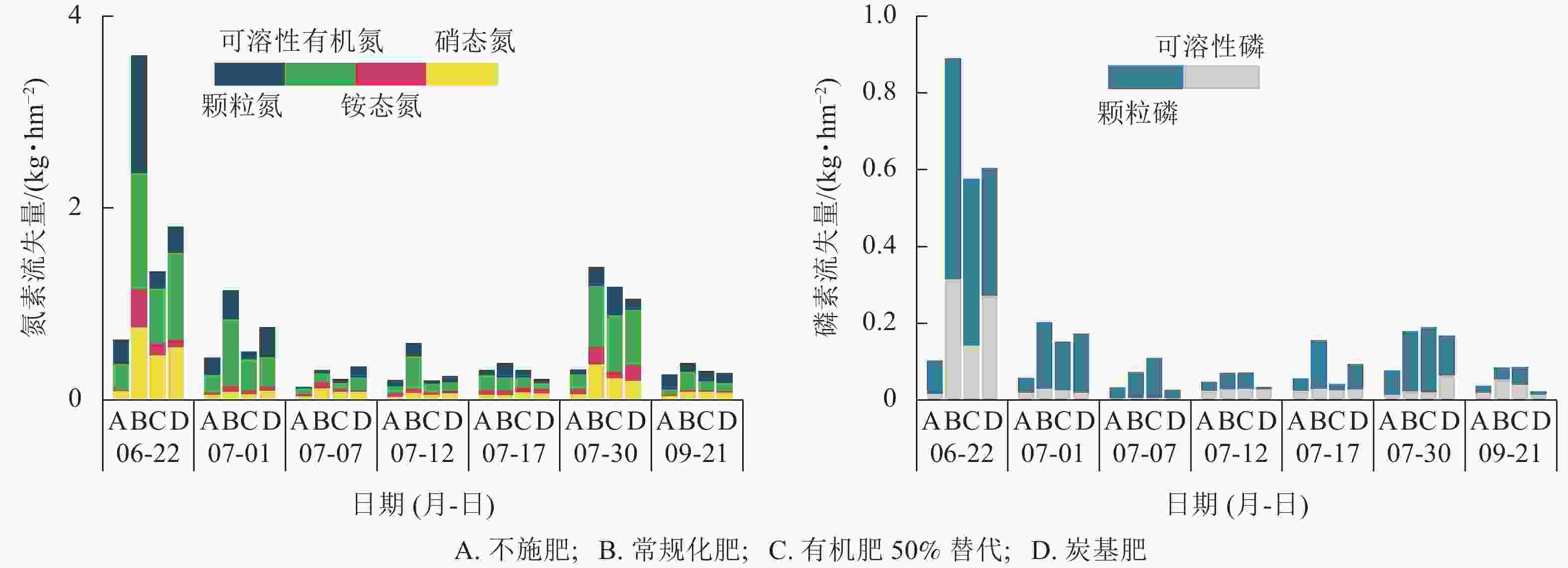
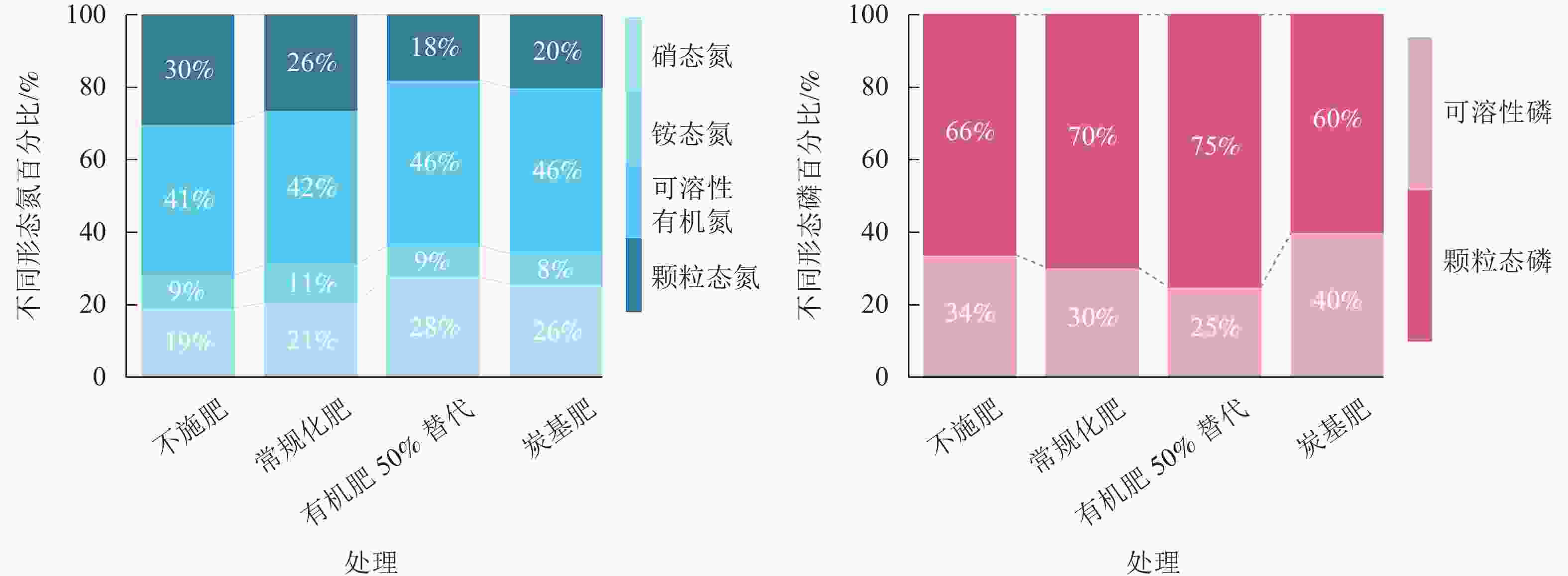
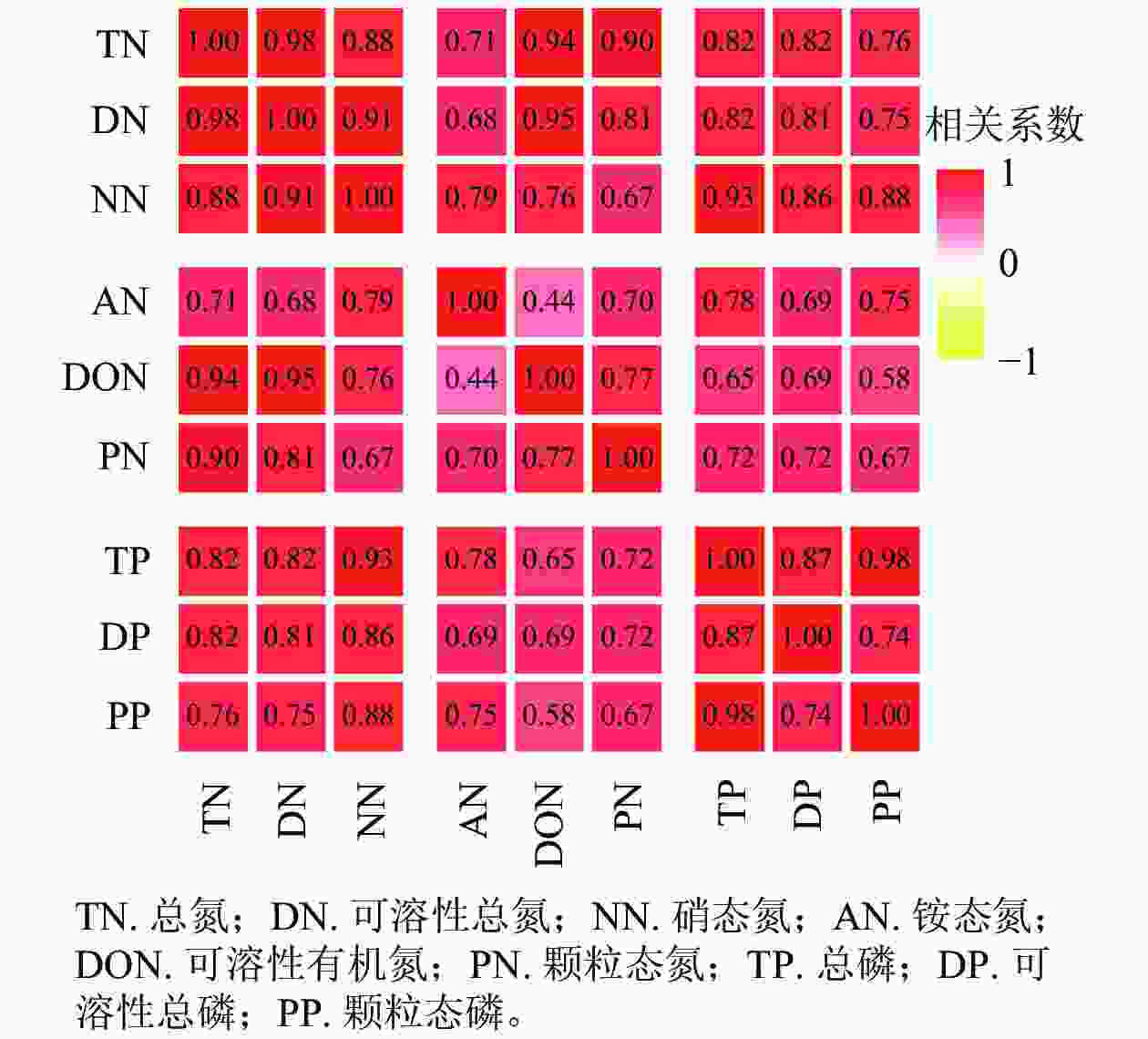

 DownLoad:
DownLoad:
